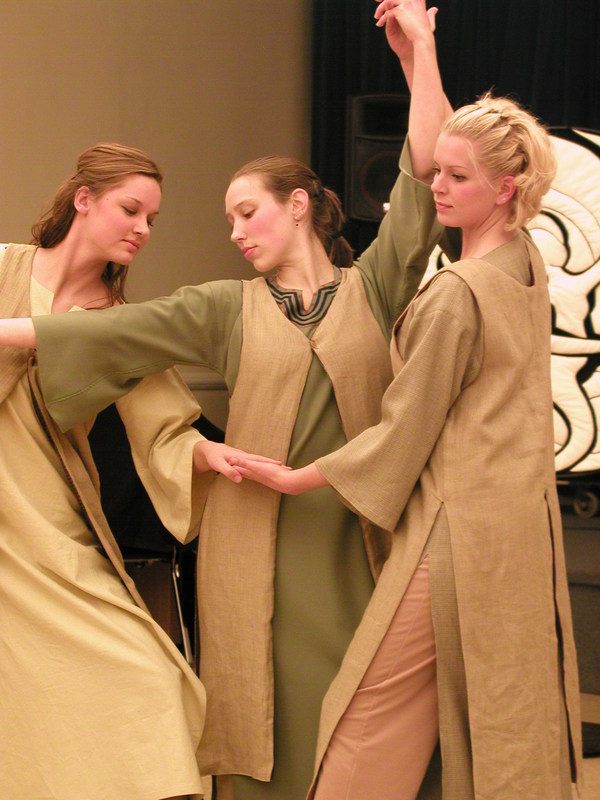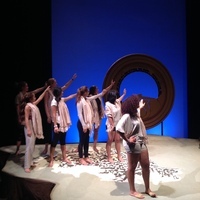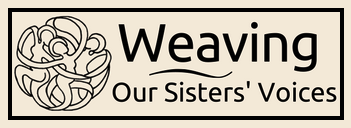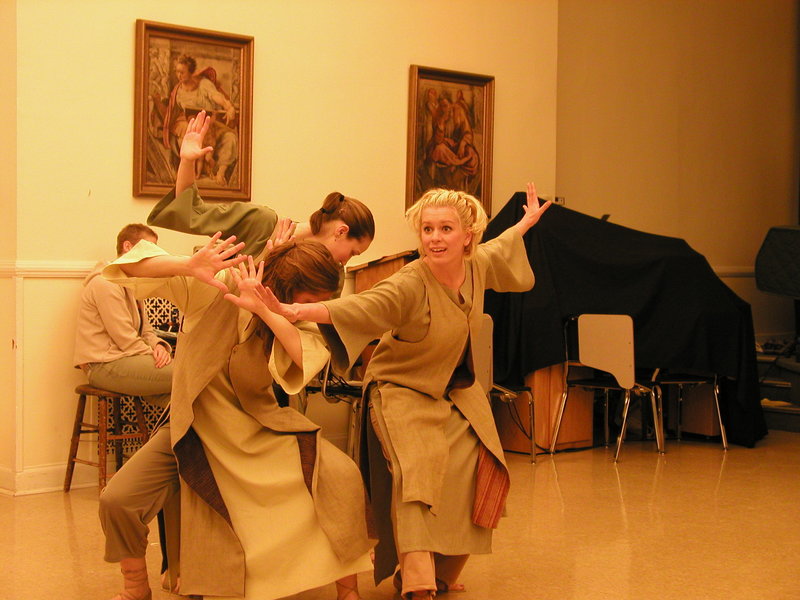Empowering an Ensemble
Sister, your actions took courageFor this I commend youScene 6 – CourageTamar (Gen 38; Ruth 4:12; 1 Chr 2:4)
At the start of each production, as the prologue developed in rehearsal, I could feel my voice strengthen and reignite that courage as a director. It was so delightful to think of each line of poetry as a score of music to embody and as a deep well of imagery to dive into.

The 2006 cast wove not only their voices, but their bodies in storytelling.
Photo courtesy of Suzanne Ostersmith
Early in any rehearsal, my goal is to find a way for the ensemble to gain confidence in me as a leader with a vision, in each member of the cast for their individual contribution, and in each other as an important member of the ensemble. We begin with physical and group connections and the natural parsing of the language.
There is a tradition in theatre to spend the first rehearsal doing a read-through. Typically the director, the company of performers, and the design team join together around a table to read through and listen to the script. This tradition is very practical in that it gives the performers and everyone on the team a sense of the entire production before one even begins. For this show this read-through is particularly important. One can read the script, but it isn’t until hearing the poetry aloud that the script begins to resonate. Performers often say that once they hear a script vocalized in the first read through they begin to really get excited for the production.

The 2015 cast rehearses, reaching out to their sister being healed.
Photo courtesy of Suzanne Ostersmith.
I am cognizant of the ways in which I build the group. In addition to rehearsal timing, finding a way for the performers to connect as people beyond the script is an important part of the start of most rehearsals. Psychologist Bruce Tuckman first came up with the “forming, storming, norming and performing” catch phrases for the growth and development of a group. I see this happening with each show I direct. Rehearsals begin with a bit of hesitation, trying to figure out how to relate to the script and each other. As I see us moving into storming you can see some concern of how ‘big’ of a role they have and how their time is being used, and I find this a great time to have them problem solve together to get them to move towards norming. In norming I find they are connecting on a deeper level and I can see that relationships are building beyond the rehearsal and the prescribed activities I set for them. And finally performing, what an apt name! When they are ready to perform I see them relying on each other and the production team, no longer are they turning to me for input on how to solve problems, they are doing it, and I happily move out of the picture.
"As we began the rehearsal process, we were initially asked to do a cold reading of the script itself. The cast of nine, strangers to me at this point, dove head-first into the piece with a sense of excitement paired with the nervous uncertainty that comes with meeting new people and entering a new community. I too felt this surge of excitement. I was eager to see what could become of such a heavy and emotional work of poetry and I could not wait to submerge deeper into the process."
– Olivia Roberts, cast 2015
I have always been attracted to the saying about teaching “Rather than be a Sage on the Stage, be a Guide on the Side”. That is how I see my role. Rather than just spewing content like so many academic classes, I get to be a ‘guide on the side’, working with my students as a team and eventually letting them fully take over. Isn’t that learning at its best? And the chance to do that with Weaving Our Sisters' Voices is even more powerful because I see what the words, stories and process does for these young women. These stories are still relevant today, and ensemble theatre is still relevant today. Not only do the women in the Bible inspire and encourage the performers, but the women working on the show together also inspire and encourage each other. I am honored to play a role in encouraging these women, and students can be surprised by the connections we make together. Students over various productions of Weaving Our Sisters’ Voices have remarked the following:
"This year hasn’t been easy and through this play I have been able to find a refuge from all of it, and along the way learn so much about what it means to be a woman, but especially about what it means to be ME. From the smallest issues, like being scared to dance, to the biggest ones, like dealing with the Conflict, you have been with me and supported me through it the whole time."
– Mary Rose Davis, cast 2010
We had the luxury of bringing in Linda Schearing to various rehearsals was helpful for the actors to ask questions. Because of the style of the production and the focus on the contemporary message, she often truncated large portions of a story to get to the meat of it. This created a powerful dramatic flow, but we couldn’t just breeze over significant sections without fully understanding their meaning and sometimes physicalizing them. We would often underline certain words and sections of the text to ask her about at the next rehearsal. For example, in The Conflict these words are written:
On the journey back to Ephraim
We stopped at a little town of Gibeah
Tired and weary
We entered the house of an old man and his daughter
WSV The Conflict
How do you say those words? What are the specifics of those two towns mentioned? Theatrically, just saying them felt hollow, but we couldn’t slow down the lines. To fill the time and give a greater sense of the journey, the performers travelled about the stage circuitously, shifting lines from one to another, and then create a threshold of the “house of an old man and his daughter”.
Theatre is a living, breathing art that is specific to the moment and the production. With one actor it may be right to be seething and sad in her anger, for another to be loud and combative, and yet for another to be quiet and driven. Theatre is about making the playwrights words authentic. I allowed myself to be flexible with each production, inviting the nuances of each artist to bring what they needed to, rather than forcing the actors perfrom just like their predecessors.
Suzanne Ostersmith

